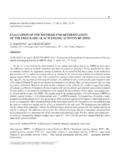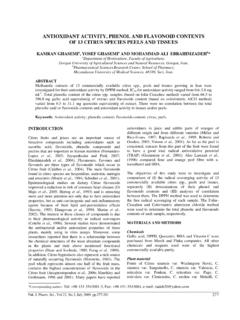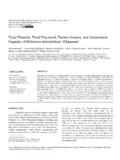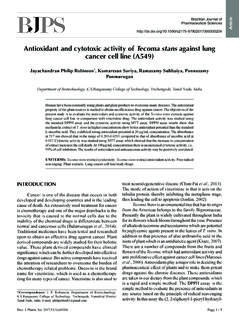Transcription of Evaluation of the Antifungal and Antioxidant …
1 Abstract Aloe vera has been used worldwide both for pharmaceutical, food, and cosmetic industries due to the plethora of biological activities of some of its metabolites. The aim of this study was to evaluate the Antifungal and Antioxidant activities of the leaf extract. The Antifungal activity was determined by the agar-well diffusion method against plant and human fungal pathogens. The methanol and ethanol portions of the extracts studied were more bioactive than ethyl acetate portion. It was also observed that the activity was more pronounced on plant pathogen than human pathogen except Candida albicans. This is an indication that the extract has the potential to treat plant fungal infections. The Aloe extract showed the significant Antioxidant activity by the DPPH radical scavenging method.
2 Therefore, the Aloe extract provided as natural Antioxidant has been used in health foods for medical and preservative purposes. Keywords Aloe vera, Antifungal , Antioxidant , DPPH . I. INTRODUCTION EDICINAL plants represent a rich source of antimicrobial agents [1] and natural antioxidants [2]. Many of the plant materials used in traditional medicines are readily available in rural areas at relatively cheaper than modern medicines [3]. Plants generally produce many secondary metabolites which constitute an important source of microbicides, pesticides and many pharmaceutical drugs. Plant products still remain the principal source of pharmaceutical agents used in traditional medicine [4-5]. Aloe vera products have long been used in health foods for medicinal and preservative purposes.
3 [6-8]. There are more than 360 different species of Aloes grown in the dry regions of North American, Europe and Asia. Aloe vera L(syn.: Aloe barbadensis Miller) is a perennial succulent plant belonging to the Aloeaceae family (sub-family of the Asphodelaceae) [9]. There are many studies showing that resistance to infection is enhanced by Aloe either in humans or in animals, whether the infective agent is a bacterium, virus or fungus [10-11] and Antioxidant activity [12-13]. Aloe vera has also been shown to be a potential therapeutic agent for the treatment of sepsis and hepatotoxicity [14-15]. Glucomannan and acemannan can accelerate wound healing, activate macrophages and demonstrate antineoplastic, antiviral effects [16]. Reference [17] showed that the Antioxidant potential of Aloe vera diminished due to the infection by Alternaria alternata, a deuteromycete fungus.
4 Therefore it should be needed to screen the medicinal plants before they are used for therapeutic preparations. Tin Aye Khaing is with Mandalay Technological University, The collection of the plant material for medicinal preparation is however indiscriminate without any attention paid to the origin, purity, safety, efficacy, botanical identity and method of cultivation. Hence the objective of this work has been to validate the presence of the Antifungal and Antioxidant activity of A. vera that grown in our university s campus, to use A. vera leaf extract as natural antiseptic agents and as a food additive and to control the plant disease instead of chemical fungicide. II. MATERIALS AND METHODS A. Collection of Plant Sample The leaves of Aloe vera were collected from the Technological University Campus, Kyaukse, Mandalay Division, Myanmar.
5 B. Preparation of Crude Extract Fresh A. vera whole leaves were washed with distilled water, chopped into small pieces, air-dried and grinded into powder. The powder was extracted with 95% ethanol at 90 C for 6 h and evaporated into concentrated extract by using distillation set. This concentrated leaf extract was used for further experiments. C. Fungal Strains Seven fungal strains were collected from the Department of Biotechnology, Mandalay Technological University, Mandalay. These were four human pathogenic strains and three phytopathogenic strains. Human pathogenic strains were Aspergillus niger, Candida albicans, Crytococcus neoformans, Penicillium maneffei and phytopathogenic fungi were Fusarium oxysporum, Phythium sp. and Rhizoctonia solani. D. Evaluation of Antifungal Activity Antifungal Activity was performed by agar well diffusion method.
6 The fungal strains were cultured in their respective broths in a water-bath shaker for 48 hr below 30 C. After incubation, they were harvested and 100 l of fugal suspensions were swabbed onto SDA (Sabouraud s Dextrose Agar) medium. Agar wells were carried out by punching out equally spaced wells on the medium that has been heavily seeded with the test organisms. Then, the crude leaf extracts were dissolved in methanol, ethanol and ethyl acetate and filled in the wells and 70 % ethanol was used as control. After filling, the plates were inoculated at 37 C for overnight and inhibition zones (in mm) were determined. Tin A. Khaing Evaluation of the Antifungal and Antioxidant Activities of the Leaf Extract of Aloe vera (Aloe barbadensis Miller) MWorld Academy of Science, Engineering and Technology 75 2011610 E.
7 Qualitative Determination of the DPPH Radical Scavenging Activity Briefly, different concentrations of the extracts and ascorbic acid were prepared between 625 and 10000 ppm. 100 l of each sample was put in the 96-well microtitre plate, added 100 l of mM DPPH solution and incubated for 30 min in the dark. Control was 100 l methanol and 100 l DPPH solution. The compounds with antiradical activity changed color as yellow from the purple-blue. F. Quantitative Determination of the DPPH Radical Scavenging Activity The Antioxidant activity of the Aloe extract was evaluated spectrophotometrically following the DPPH method described by Reference [18]. Different concentrations of the extracts 5, 10, 15, 20 and 25 g/ml) were prepared and mixed 1 ml of them with 2 ml of a freshly prepared DPPH solution ( ); then, each particular sample was mixed thoroughly and kept in the dark for 30 minutes, at room temperature.
8 After that, each mixture was tested for the DPPH radical-scavenging activity by reading the absorbance at 517 nm on a UV-VIS spectrophotometer. As blank was used a solution prepared by mixing 1 ml of methanol with 2 ml of the DPPH solution ( ) and reading at the same wavelength. In addition, to eliminate the absorbance of the crude extracts at this wavelength, blank samples were prepared with 1 ml of each extract and 2 ml of methanol. The Antioxidant activity percentage was calculated following the formula: Antioxidant activity (%) = [(AC -AE) /AC] x 100 Where AC is the absorbance of a DPPH solution without extract, AE is the absorbance of the tested extract, which is equal to the absorbance of the plant extract plus the DPPH ( ) minus the blank extract absorbance [19]. As standard ascorbic acid at different concentration 5-25 was used.
9 The EC50 value, defined as the concentration of the sample leading to 50% reduction of the initial DPPH concentration, was calculated from the linear regression of plots of concentration of the test extracts against the mean percentage of the Antioxidant activity. III. RESULTS AND DISCUSSIONS The results of the study provide scientific basis for the use of the plant extract in the future development as Antioxidant and Antifungal agent. A. Evaluation of Antifungal Activity Crude extract of A. vera was dissolved in methanol, ethanol and ethyl acetate at a concentration of 30 mg-1 and were tested against human pathogenic strains such as Aspergillus niger, Candida albicans, Crytococcus neoformans, Penicillium maneffei and phytopathogenic fungi such as Fusarium oxysporum, Phythium sp.
10 And Rhizoctonia solani. The results of the Antifungal activity of the A. vera were shown in Table I. TABLE I Antifungal ACTIVITY OF ALOE VERA LEAF EXTRACT The methanol and ethanol portions of Aloe leaf extract were shown to display Antifungal activity against all tested fungi except Candida albicans ranging between 11 and 18 mm, while ethyl acetate portion demonstrated Antifungal activity exhibited only against three fungi Penicillium maneffei, Fusarium oxysporum and Phythium sp. at the tested concentration. Among three portions of A. vera extract, methanol portions revealed highest Antifungal activity whereas the control representing only 70% ethanol did not exhibit inhibition on the tested fungi. The higher Antifungal activity exhibited by the methanol and ethanol portions may be due to the presence of substantial amounts of polar constitutes from the plant material.







